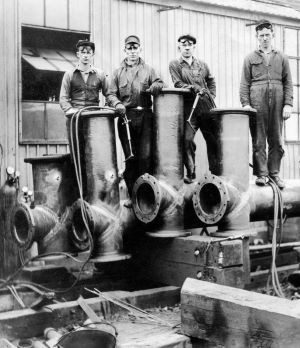FOR IMMEDIATE RELEASE | September 09, 2021
Birthplace of the petrochemical industry garners Chemical Landmark designation
WASHINGTON, Sept. 9, 2021 — Innovations at Union Carbide that laid the foundation for the modern petrochemical industry are being honored with the American Chemical Society’s (ACS’) National Historic Chemical Landmark designation. The dedication ceremony will be held on Sept. 10 in Clendenin, West Virginia, where this now-global industry had its modest start a century ago.
In 1920, thanks to the vision of George Curme Jr., Ph.D., Union Carbide formed a company to develop a process to manufacture ethylene. The move to ethylene was a revolutionary step because acetylene was the workhorse chemical of the day. Union Carbide, which is now a subsidiary of Dow Chemical, began operating its first ethylene facility in 1921 in Clendenin. Curme and his Union Carbide colleagues also commercialized processes to convert ethylene into several other useful compounds, thereby launching a business sector that has evolved into today’s multi-billion-dollar petrochemical industry.
“These ethylene-based compounds are now used in numerous products — including clothing, packaging, detergents, paints, durable goods and construction materials,” says ACS President H. N. Cheng, Ph.D. “So the achievements we are now celebrating show that chemistry truly is part of our everyday lives.”
This is the first National Historic Chemical Landmark in West Virginia. “The state has a long history of excellence in chemical production and research,” says Micheal Fultz, Ph.D., who prepared the Landmark nomination on behalf of the ACS Kanawha Valley Section, which includes Clendenin. “The Kanawha Valley is known as Chemical Valley due to the resources, knowledge and transportation systems that help bring products to the market,” adds Fultz, a professor of chemistry at West Virginia State University. “The Landmark dedication recognizes a major accomplishment of talented people who helped provide society with a new building block — ethylene.”
“Dow and Union Carbide are proud to be part of the long history of innovation in West Virginia and the resulting impact on the entire chemical industry,” says Shannon Huber, senior site manufacturing director at Dow West Virginia Operations. “Dow’s efforts remain rooted in our ambition to be the most innovative, customer-centric, inclusive and sustainable materials science company in the world.”
Participants in the Landmark dedication ceremony are expected to include Roger Hanshaw, speaker of the West Virginia House of Delegates, who holds a Ph.D. in chemistry; Clendenin Mayor Kay Summers; Cheng and Fultz.
As part of the Landmark celebration, West Virginia State University has established the Dr. George Curme Jr. Scholarship for college students who want to change their lives through the power of a STEM (science, technology, engineering and mathematics) education. The funds are intended for West Virginia residents who volunteer for community outreach and service. The first recipients will be named this fall.
ACS established the National Historic Chemical Landmarks program in 1992 to recognize seminal events in the history of chemistry and to increase awareness of the contributions of chemistry to society. Past Landmarks include the discovery and production of penicillin, the invention of synthetic plastics and the works of such notable scientific figures as educator George Washington Carver and environmentalist Rachel Carson. For more information, visit www.acs.org/landmarks.
To automatically receive press releases from the American Chemical Society, contact newsroom@acs.org.
Note: ACS does not conduct research, but publishes and publicizes peer-reviewed scientific studies.
Media Contact
ACS Newsroom
newsroom@acs.org


